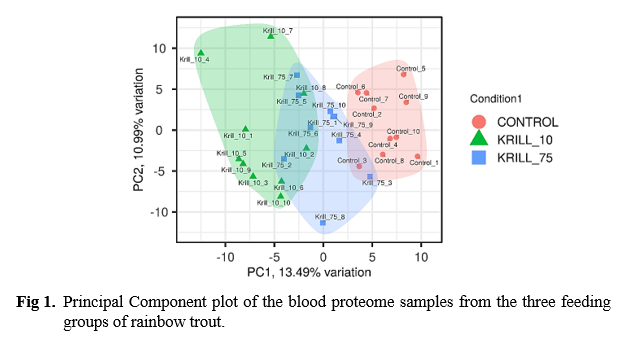EFFECTS OF KRILL MEAL ON PHENOMIC RESPONSES AND BLOOD PROTEOMICS IN RAINBOW TROUT REARED IN A CHALLENGING HIGH-TEMPERATURE
Introduction
Temperature is a critical factor in climate change, with its effects becoming particularly pronounced during heatwaves, defined as periods when the mean or maximum temperature increases by at least 3–5°C for a maximum of three consecutive days. Such conditions significantly impact aquatic environments, often resulting in mass mortalities. The reoccurrence of heatwaves poses a substantial challenge for the salmon and rainbow trout industry. There exists a strong correlation between the heat resistance of fish and their diet. Krill meal (KM) offers a well-balanced amino acid profile akin to fish meal, along with high levels of phospholipids, n-3 polyunsaturated fatty acids (n-3 PUFAs), astaxanthin, vitamins, and minerals. Consequently, KM has the potential to alleviate heat stress in cultured fish due to its functional nutrient content. This study aims to evaluate the phenomic responses rainbow trout fed experimental diets containing 0%, 5%, 7.5%, and 10% krill meal (KM) under a challenging high temperature (14°C-control, 14°C→21°C, and 21°C→23°C). The blood proteome of rainbow trout fed control, KM7.5 and KM10 diets was also assessed to understand the role of the altered proteins in the fish’s metabolic and immune systems when maintained at 21°C→23°C.
Material and Methods
Female rainbow trout juveniles (61.8 g) were placed into two RAS with 16 cylindrical tanks (4 replicates per dietary group) of 350 L capacity at 25 fish/tank. Five iso nitrogenous (46% CP) and isolipidic (28% CL) diets were formulated using KM (0, 5, 7.5, and 10 mg/kg; purity: 99%, Aker Qrill Company). Fish were fed twice daily until apparent satiety. During Phase I, four experimental diets were randomly assigned to four replicate tanks using a randomized block design across two RAS. Throughout the 70-day period, fish were manually fed to apparent satiation at 14°C. Following Phase I, one RAS system was designated as the heat stress group. The water temperature of two tanks per experimental group was increased by 1°C daily until reaching 21°C, while the remaining tanks in the second RAS were maintained at 14°C as a control. During Phase II (14°C→21°C) , fish continued receiving the same diets, and feed intake was recorded for 7 days. Subsequently, the water temperature in the heat stress group was increased from 21°C to 23°C over 3 days, and the fish were kept at this temperature for 7 more days (Phase III , 21°C→23°C ). At the conclusion of each phase, three fish were sampled for fillet fatty acid and proximate composition analysis. Blood samples were only collected for proteomic analysis after Phase III. All data were statistically compared with a two-way ANOVA, where a 4×2 factorial design was followed with diet and heat stress temperature as fixed factors.
Results
At the conclusion of Phase I (14°C), the final weight (g/fish) and thermal growth co-efficiency (% TGC) in the KM5 group were numerically higher than the control, while there was no significant difference between the KM5 and KM10 fed fish. Overall, no significant differences in feed intake or feed conversion ratios (FCR) were observed across the different diets during Phase I. In Phase II (14°C→21°C), there was a discernible trend showing increased growth in fish fed with KM5 at 21°C compared to those maintained at the control temperature of 14°C. Regardless of the dietary treatment, TGC was significantly higher in fish fed the experimental diets at 21°C than in the fish that had remained at 14°C. In Phase III (21°C→23°C), the final growth of fish fed at 14°C was greater than that of fish fed at 23°C irrespective of the dietary treatments. Fish fed with KM5 and KM7.5 showed higher growth than those fed KM10 during Phase III (21°C→23°C). While fatty acid composition remained unchanged in Phase I, EPA increased in KM5, KM7.5, and KM10 at 21°C. Docosahexaenoic acid (DHA) was sensitive to heat and increased in fish kept at 21°C, irrespective of dietary treatment. A similar trend was observed in fish maintained at 23°C in Phase III. The DHA/EPA ratio was significantly affected by diet and heat stress; however, no significant interaction effects were observed. Proteomic analysis of rainbow trout exposed to KM7.5 and KM10 revealed significant physiological adaptations (Fig. 1). The higher doses of krill meal (KM7.5 and KM10) elicited stronger upregulation of oxygen transport proteins, particularly haemoglobin subunit alpha-1, and showed comprehensive activation of complement system components, with six proteins significantly upregulated, indicating a better coping ability of trout under challenging temperature, which correlated well with improved survival in KM diets, displaying a dose response, with KM10 resulted in the highest survival at 23°C. Functional analysis of the differentially expressed proteins in the blood proteome will be presented.
Discussion
The observations of the present study support the clear benefits of KM in the rainbow trout diets under heat-stress conditions with better growth and survival. The primary phenomic responses to KM supplementation are intake-linked and their benefits when used in diets under heat stress. Based on blood proteomic analysis, these results demonstrated a robust cellular response to both the KM7.5 and the KM10 interventions that was not reflected in the growth performance of the fish. This body of work notably makes a strong case for further exploring the use of KM in aquafeeds as a functional ingredient to improve robustness in rainbow trout under heat stress. It is essential to further investigate this aspect to achieve a more comprehensive understanding of the potential benefits of KM inclusion, particularly concerning the purported enhancement of oxygen-carrying capacity under heat stress in actual culture conditions.
